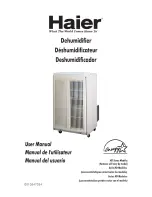
2.1D In A Remote Area, Duct Outlet Only.
A simpler remote installation method than above uses ducting
between the Santa Fe discharge and the humid room; the
Santa Fe inlet draws air from the room in which it’s located.
This works well if there is an adequate air flow path between
the two rooms; e.g. high door undercut, louvered door or wall
grill. This eliminates the need to remote mount the humidity
control. There are several potential disadvantages to using
this method. First, humid air is drawn into the room where
the Santa Fe is located. Second, to accurately sense humidity,
the blower in the Santa Fe may need to run continuously to
draw air from the humid room into the Santa Fe room. Third, a
slight negative pressure is created in the room with the Santa
Fe which could back draft open combustion devices located
there. If such devices are present, call the factory for specific
instructions before using this installation method or consider
the option below.
2.1E In A Remote Area, Duct Inlet Only.
When the Santa Fe is located in a room separate from
the main area to be dehumidified, it may be desirable to
dehumidify and/or slightly pressurize that room. Pressurization
assures that open combustion devices do not back draft. This
can be accomplished by installing a duct from the humid
room to the Santa Fe inlet and by allowing the Santa Fe to
discharge dehumidified air into the room in which it’s located.
An adequate air flow path must exist between the two rooms
for this method to work well. An additional humidity control may
need to be mounted in the humid area and wired to the Santa
Fe to accurately maintain the desired humidity. Local electrical
codes must be followed when wiring the control.
2.2 Electrical Requirements
The Santa Fe plugs into a common grounded outlet on a 15 Amp
circuit. It draws between 6 and 7 Amps under normal operating
conditions. If used in a wet area (pool, spa room, or basement
prone to flooding), a ground fault interrupter protected circuit is
required.
2.3 Condensate Removal
Condensate drains by gravity via the clear hose extending from
the unit. Route hose to a floor drain. Use care to keep the hose as
flat to the floor as possible. Excessive humps or kinks will prevent
proper drainage.
If the Santa Fe is located too far from a floor drain for the attached
hose to reach, 1/2” PVC pipe can be used to extend it. It is
commonly available in 10’ lengths from building supply, plumbing
and hardware stores. It will slide tightly inside the end of the drain
hose.
If more than one length of pipe is required they can be joined with
a short piece cut from the end of the drain hose.
2.4 Ducting
2.4A Optional Ducting
An inlet shroud with an 8” round collar and an 8” round
exhaust collar are available from the factory that will allow
round ducting to be attached to the inlet and/or outlet of the
Santa Fe.
2.4B Ducting for Dehumidification
Ducting the Santa Fe as mentioned in sections 2.1B-2.1E
requires consideration of the following points:
Duct Sizing:
For total duct lengths up to 25 feet, use a
minimum 8” diameter round or equivalent rectangular. For
longer lengths, use a minimum 10” diameter or equivalent.
Grills or diffusers on the duct ends must not excessively
restrict air flow.
Isolated Areas:
Effective dehumidification
may require that ducting be branched to isolated, stagnant
areas. Use 6” diameter branch ducting to each of two or three
areas, use 4” to each of four or more areas.
3. Operation
3.1 Humidity Control Adjustment
The dehumidifier will run continuously until relative humidity
(RH) is reduced to the humidity control dial setting. Setting the
humidity control to lower RH levels will
NOT
increase the unit’s
dehumidification rate, it will simply run longer to reduce the
area’s RH to the setting. The Santa Fe unit (and refrigerant based
dehumidifiers in general) will reduce a warm space’s RH to a
lower level than that of a cool space. For example, the Santa Fe
may reduce an 80° F space to 30% RH. However, if the same
space is 65° F, it may only reduce it to 40% RH. It is therefore
pointless to set the humidity control to excessively low levels
in cool rooms. Doing so will result in long periods of ineffective
dehumidifier run time. Quality humidity meters are available from
the factory and are recommended to accurately monitor humidity
levels.
3.2 Blower Switch
Turning “ON” the fan switch will cause the unit’s internal blower
to run continuously, whether the unit is dehumidifying or not. This
function is desirable if the unit is used for air circulation.
4. Maintenance
4.1 Air Filter
The Santa Fe is equipped with 2 air filters. A foam pre-filter
followed by a standard MERV-11 65% efficient pleated fabric
filter. These should be checked every six months. Operating
the unit with dirty filters will reduce dehumidifier capacity and
efficiency and may cause the compressor to cycle off and on
unnecessarily on the defrost control.
SANTA FE INSTALLER'S AND OWNER'S MANUAL
2
Santa Fe Installer’s & Owner’s Manual
3
Santa Fe Installer’s & Owner’s Manual

































